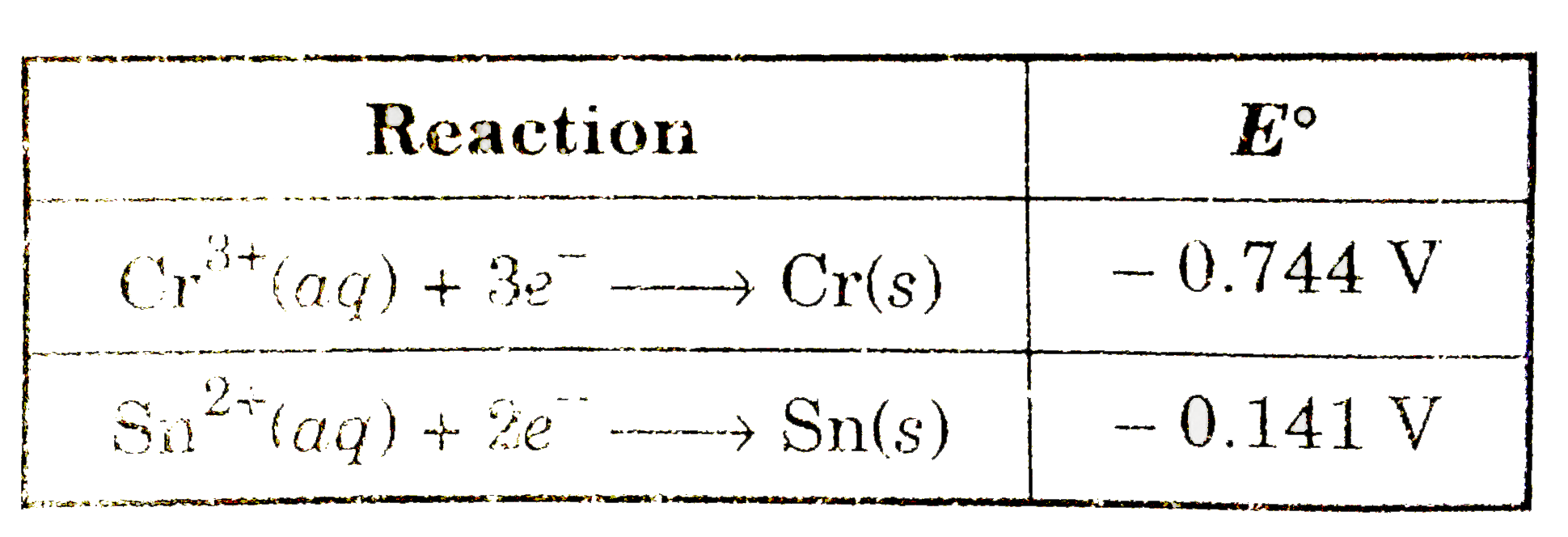Nickel metal is added to a solution containign 1.0 m Pb2+(aq) and 1.0MCd^(2+)(aq).Usethestandardreductionpotentials→determinewhichreaction(s)willour.<br>Reaction1:Ni(s) + Pb^(2+)(aq) rightarrow Pb(s) + Ni^(2+)(aq)<br>Reaction2:Ni(s) + Cd^(2+)(aq) rightarrow Cd(s) + Ni^(2+)(aq)<br>{:("Reaction", E^(@)), (Pb^(2+)(aq) + e^(-) rightarrow Pb(s) , -0.13V), (Ni^(2+)(aq) + 2e^(-) rightarrow Ni(s), -0.23V), (Cd^(2+)(aq) + 2e^(-) rightarrow Cd(s), -0.40V):}
1 only
2 only
Both 1 and 2
Neither 1 nor 2
The correct Answer is:A
Step by step video, text & image solution for Nickel metal is added to a solution containign 1.0 m Pb^(2+)(aq) and 1.0 M Cd^(2+)(aq). Use the standard reduction potentials to determine which reaction(s) will occur. Reaction 1: Ni(s) + Pb^(2+)(aq) rightarrow Pb(s) + Ni^(2+)(aq) Reaction 2: Ni(s) + Cd^(2+)(aq) rightarrow Cd(s) + Ni^(2+)(aq) {:("Reaction", E^(@)), (Pb^(2+)(aq) + e^(-) rightarrow Pb(s) , -0.13V), (Ni^(2+)(aq) + 2e^(-) rightarrow Ni(s), -0.23V), (Cd^(2+)(aq) + 2e^(-) rightarrow Cd(s), -0.40V):} by Chemistry experts to help you in doubts & scoring excellent marks in Class 12 exams.
Topper's Solved these Questions
- BOOK - GRB PUBLICATIONCHAPTER - ELECTROCHEMISTYEXERCISE - Latimer Diagram, concentration cells117videos
ELECTROCHEMISTY
- BOOK - GRB PUBLICATIONCHAPTER - ELECTROCHEMISTYEXERCISE - Batteries10videos
ELECTROCHEMISTY
- BOOK - GRB PUBLICATIONCHAPTER - ELECTROCHEMISTYEXERCISE - Subjective type39videos
ELECTROCHEMISTY
- BOOK - GRB PUBLICATIONCHAPTER - D-BLOCK ELEMENTSEXERCISE - Subjective Type18videos
D-BLOCK ELEMENTS
- BOOK - GRB PUBLICATIONCHAPTER - ENVIRONMENTAL CHEMISTRY EXERCISE - Straight objective type40videos
ENVIRONMENTAL CHEMISTRY
Similar Questions
Given these standards reduction potentials, what is the free energy change (in kJ. Mol^(-) for the reaction:
Pb(s)+2Ag+(aq)→Pb2+(aq)+2Ag(s)
Ag+(aq)+e−→Ag(s) E∘=0.80V
Pb2+(aq)+2e−→Pb(s) E∘=−0.13VView SolutionAg+(aq)+e−→Ag(s) E∘=0.80V
Co2+(aq)+2e(−)→Co(s) E∘=−0.28V
Use the standard reduction potentials to determine the standard potential for the reaction:
Co(s)+2Ag+(aq□)→Co2+(aq)+2Ag(s)View Solution
Knowledge Check
- Question 1 - Select One
Use the information in the table and calcualate E∘ for this reaction.
Ga(s)+3Tl+(aq)→3Tl(s)+Ga3+(aq)
ReactionE∘Ga3+(aq)+3e−→Ga(s)−0.529VTl+(aq)+e−→Tl(s)−0.336VA0.479VB0.193VC−0.193VD0.479V - Question 2 - Select One
Cu2+(aq)+Zn(s)→Cu(s)+Zn2+(aq), E∘=1.1V
Zn2+(aq)+2e−→Zn(s), E∘=−0.76V
Cu2+(aq)+4NH3(aq)→[Cu(NH3)4]2+(aq)+2e− is:A0.34 VB0.76 VC0.26 VD0.14 V - Question 3 - Select One
Given the standard reduction potentials, which statement is correct?
Cu2(aq)+2e−→Cu(s)E∘=0.34V2H+(aq)+2e−→H2(g)E∘=0.0VCr3+(aq)+2e−→Cr(s)E∘=−0.73VACr(s) will react with acid.BCu(s) will react with acid.CCu2+(aq) will react with acidDCu(s) will reacct with Cr3+(aq)
Given these standard reduction potentials, what is the standard reduction potential for
Co3+(aq)+3e−→Co(s)?
Co3+(aq)+e−→Co2+(aq)E∘=1.82V
Co2+(aq)+2e−→Co(s)E∘=−0.28VView SolutionUse the standard reduction potentials to determine what is observed at the cathode during the electrolysis of a 1.0 M solution of KBr that contains phenolphthalein.
O2(g)+4H+(aq)+4e−→2H2O(l) E∘=1.23V
Br2(l)+2e−→2Br−(aq) E∘=1.07V
2H2O(l)+2e−→H2(g)+2OH− E∘0=−0.80V
K+(aq)+e−→K(s) E∘=−2.92VView SolutionUse the standard reduction potentials:
Sn2+(aq)+2e−→Sn(s) E∘=−0.141V
Ag+(aq)+e−→Ag(s) E∘=0.800V
To calcultate E∘ for the reaction:
Sn(s)+2Ag+(aq)→Sn2+(aq)+2Ag(s)View SolutionWhat is the standard cell potential for the reaction,
2Cr(s)+3Sn2+(aq)→3Sn(s)+2Cr3+(aq)
given the E∘ values shown?
 View Solution
View SolutionIn the reaction Pb(s)+Cu2+(aq)→Pb2+(aq)+Cu(s) which is reducing agent
View Solution

